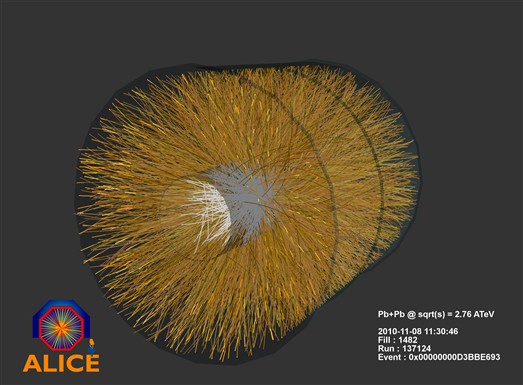| |
|
The Latest from the LHC: The success of the lead ion run continues
The success of the lead ion run continues, with the 2010 target of 121 nominal bunches achieved on Sunday, 14 November, just 10 days after the first ions were injected into the LHC. Operation under these conditions continued until Wednesday morning, when it was interrupted for a scheduled stop to replenish the lead ion source. By this time a peak luminosity of 2.8 1025 cm-2 s-1 had been reached, and over 2 µb-1 had been delivered to the experiments.
Events recorded by the ALICE experiment from the first lead ion collisions. During the stop to replenish the source, the LHC switched back to proton operation so that studies with 50 ns and 75 ns bunch spacing could continue. These studies produced a wealth of valuable information about the behaviour of the machine with 75 ns bunch spacing, with up to 824 bunches circulating in one beam at 450 GeV, and 680 bunches in both beams. Important data were also taken with 50 ns bunch spacing, allowing comparison both with runs made before the ion run started and with the behaviour of the machine with 75 ns spacing. In particular, measurements of the response of the vacuum system and of the heat loads deposited on the cryogenic beam screens will provide information essential for deciding the strategy for 2011. Accumulation of these data was considered to be of such importance that the proton run was extended until Saturday morning, beyond the time needed to replenish the lead ion source. Throughout Saturday and Sunday, the injectors and the LHC were re-optimized for ion physics with 121 bunches per beam. The polarity of the ALICE spectrometer was switched on Tuesday to allow roughly equal amounts of data to be accumulated with both polarities. The ion run is scheduled to continue until Monday, 6 December. At the time of going to press, a peak luminosity of 2.5 10 25 cm -2 s -1 had been reached, and 4.5 µb -1 had been delivered to the experiments.
by CERN Bulletin
|
|
|


